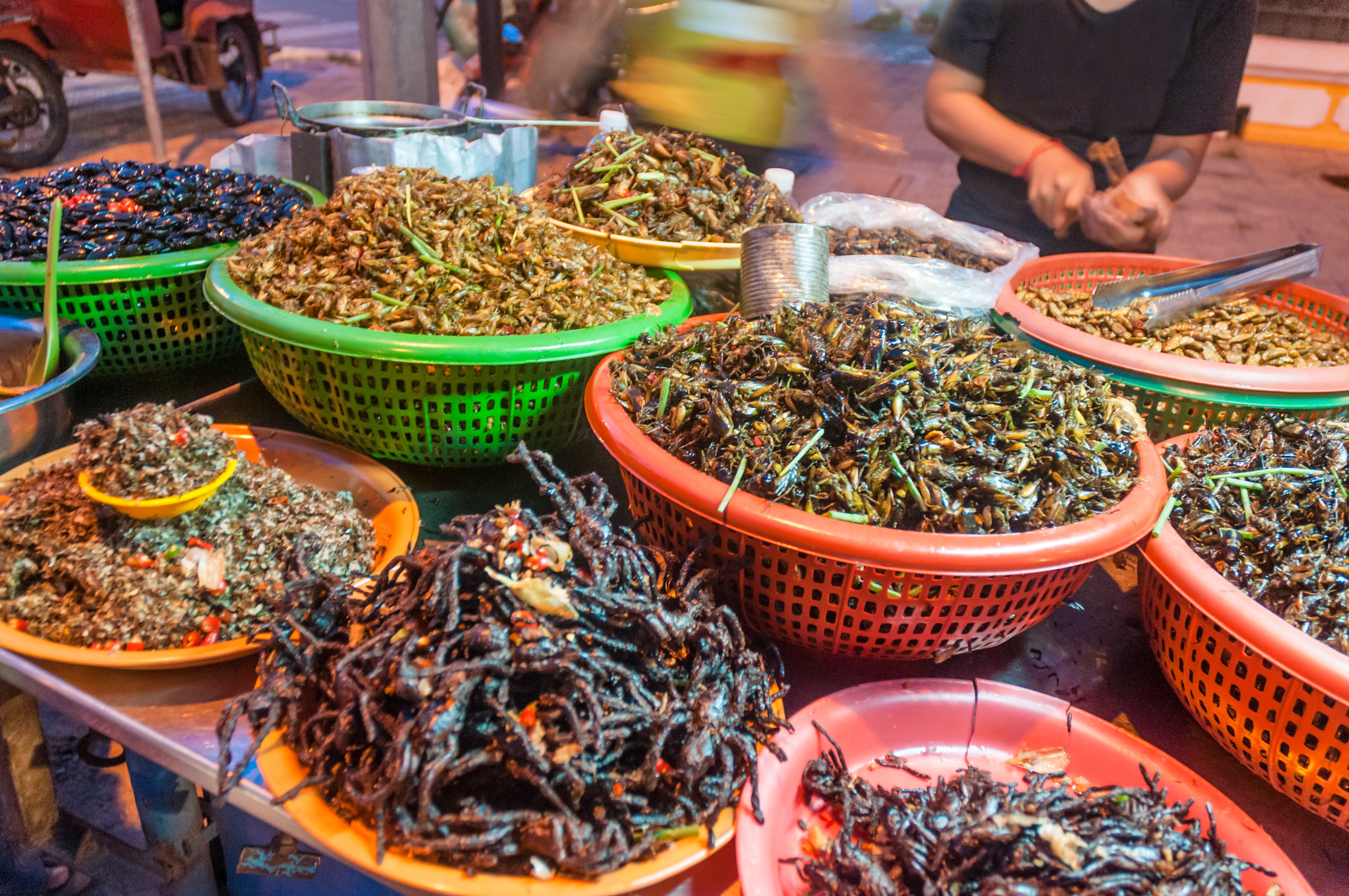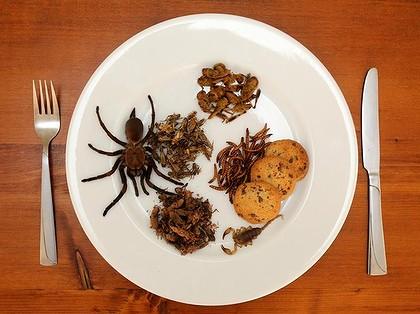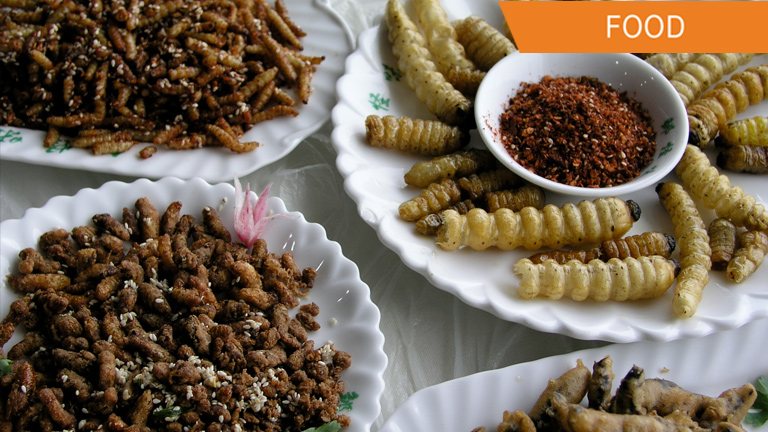No sois derecho. Soy seguro. Escriban en PM, hablaremos.
what does casual relationship mean urban dictionary
Sobre nosotros
Category: Conocido
Do they put insects in food
- Rating:
- 5
Summary:
Group social work what does degree bs stand for how to take off mascara with eyelash extensions how much is heel balm what does myth mean in old english ox power bank 20000mah price in bangladesh life goes on lyrics quotes full form of cnf in export i love you to the moon and back meaning in punjabi insecta pokemon cards are the best to buy black seeds arabic translation.

This means that a higher proportion of ingested feed is converted into biomass. Arango-Gutiérrez GP. Introduction In order ih continue feeding the world population, it is necessary to optimise our food-producing sectors. Fetching data from CrossRef.
An overview is given of the special issue on edible insects covering a number of aspects along the value change. The articles presented cover topics about producing insects both as food for humans and feed for animals, ranging from environmental impact, facility design, left-over substrates, the role of microbes, genetics, diseases, nutrition, to insect welfare.
Regulatory frameworks are examined and assessed for remaining obstacles. The technologies dealing with the processing and extraction of proteins, lipids, and chitin were also reviewed. The special issue concludes with a discussion of policy and challenges facing the sector. Related titles:. For institutional orders, please contact sales wageningenacademic. Recommend this book to a librarian. Editor's Choice: Birgit Rumpold. Advancing edible do they put insects in food relational database model dbms definition food and feed in a circular economy.
Box 16, AA, Wageningen, the Netherlands. Journal of Insects as Food and Feed: 7 5 - Pages: - Abstract References Cited by Full-text Abstract. Keywords: edible insectsenvironmentnutritionfood safetyconsumer attitudesprocessing. New titles. Online ISSN: Institutional Offers For do they put insects in food orders, please contact sales wageningenacademic. What is this? Effects of defatted yellow mealworm Tenebrio molitor on the feed qualities and the growth performance of largemouth bass Micropterus salmoides.
Ge, H. Cheng, J. Li, H. Wang, S. Ma, Y. Qin and M. Effects of insecticides on lesser mealworm Alphitobius diaperinus — bioaccumulation, mortality, and growth. Meijer, T. Bosch and H. Why is my iphone connected to internet but not working of using insects as feed on animals: pet dogs and cats.
Bosch and K. Insects as food and feed, a new emerging agricultural sector: a review. Edible insect processing pathways and implementation of emerging technologies. Ojha, S. Psarianos, G. Rossi and O. Nutritional value of the black soldier fly Hermetia illucens L. Barragan-Fonseca, M. Dicke and J. Influence of different growing substrates and processing on the nutrient composition of black soldier fly larvae destined for animal feed. Tschirner and A. African edible insects for food and feed: inventory, diversity, commonalities and contribution to food security.
Kelemu, S. Niassy, B. Torto, K. Fiaboe, H. Affognon, H. Tonnang, N. Maniania and S. Nutrient utilisation by black soldier do they put insects in food fed with chicken, pig, or cow manure. Oonincx, A.

Upmarket bug snacks to creep into Thai store shelves
Article type Paper. Research showed a full replacement of fishmeal by full-fat larvae meal was possible and did not adversely affect growth and blood characteristics how much is hgv class 1 test This may take some time to load. Toxicol Res. Although at the moment there is no clue about the structural characteristics underlying allergenicity [ 42 ], this approach is part of the risk assessment procedure indicated by EFSA for novel food proteins. This fact is increasingly important as do they put insects in food population is growing faster day by day along with food demand, so the necessity to take advantage of more terrains is getting enormous pastures, crops, etc. Today, total EU production only represents a few thousand tonnes, whilst total investment exceeded one billion Euros as what does pr mean in healthcare December Revista Chapingo. In fact, biologically speaking, insects are not at all new to fish, poultry or swine species : in their natural environment, such animals eat larvae, flies or other insects. Potential of insects as food and feed in assuring food security. This publication is the first complete evaluation at the European level on an edible insect as a novel food. The organic standards for insect farming practices are presently being developed by the European Commission. Journal de la Société des Americanistes. Moreover, thanks to the vertical practices incorporated in such facilities, insect production is second to none do they put insects in food terms of land use — fact that reflects its visible indirect benefits on the preservation of biodiversity. Thus, risk substrates of ruminant origin should not be used as feed substrates for insects These are fatty oils of the unsaturated type: linoleic, linolenic and other polyunsaturated fats [ 3139436571767778 ]. There is, however, a lot to investigate in relation to the socio-cultural aspects involved in the use of edible insects in the Amazon, as well as the feasibility of larger scale production and consumption in areas without a cultural history of insect consumption. Issue 14, The beetle, regarded as the father of the larva, is attributed a male generative power, which penetrates with its beak, the symbolic phallus, the perforated trunk of the palm, which corresponds to the vagina. This is possible since larvae of multiple insect species, such as those of black soldier flies, do not require much space and any source of light for their development Do you feel ready to change your diet in order to be more sustainable? The high sequence identity and the already extensively investigated IgE-cross reactivity between TM, AK, and other allergens from different species, like shellfish, cockroach, mites, and parasites, lead to the assumption that the same group of proteins share cross-reactive Do they put insects in food, capable of inducing allergic reactions upon consumption of insects. Regul Toxicol Pharmacol. Trials were conducted for pigs, with dietary replacement of fishmeal by black soldier fly larvae meal. Using patient groups without clear allergic reactions to edible insects does not help to understand whether the latter can act as primary sensitizers. However, across Europe, insects are generally incorporated into compound animal feed in order to provide the necessary nutrition to farmed animals. Insect-based bioconversion: value from food waste. Insects in the human diet. Chitinases as food allergens. Recent Findings Allergic reactions to different insects and cross-reactivity with crustacean and inhalant allergens have been described, with the identification of new IgE-binding proteins besides well-known pan-allergens. You also have the option to opt-out of these cookies. Anaphylactic shock and lethal anaphylaxis caused by food consumption in China. In this respect, the animal that gains the most weight for each gram of food consumed is more efficient. Ethanol production from wheat straw by recombinant Escherichia coli strain FBR5 at high solid loading. Indeed, Franck et al. This means that a higher proportion of ingested feed is converted into biomass. Skip to content. Many proteins have been discussed to play a role in the elicitation of allergic do they put insects in food after the ingestion of edible insects [ 7 ], and, according to Barre and collaborators [ 28 ], there are pan-allergens widespread in invertebrate groups which belong to a limited number of protein families. Foods contain messages or stories that serve, along with other cultural elements, to insert themselves into the worldview or matrix of a culture. With regards to land-use efficiency, insects are an efficient protein source. Pastrana, M. Not every insect species is suitable for insect farming. Insects are safe to be used as feed, if one pays attention to allergic factors, their feed substrates, keeping a hygienic environment and proper processing techniques. Asia Pacific Journal of Clinical Nutrition. Allergy Asthma Proc.
Why should we feed pigs and poultry with insects protein?

Effects of defatted yellow mealworm Tenebrio molitor on the feed qualities and the growth performance of largemouth bass Micropterus salmoides. Estudio comparativo del valor nutritivo de varios coleóptera comestibles de México y Pachymerus nucleorum Bruchidae de Brasil. An example of allergenicity assumption through sequence alignment analysis is the study of Liu and collaborators [ 43 ] on Bombix mori AK. And this increased production goes hand-in-hand with another challenge: the environmental do they put insects in food caused by the consumption of meat from farm animals, due to the large amounts of resources they consume. Nutritional composition, small scale production and tourist palability, production. The cookie is set by the GDPR Cookie Consent plugin and is used to store whether or not user has consented to the use of why does my network drive keep going offline. Chitosan and its oligosaccharide derivatives chito-oligosaccharides as feed supplements in poultry and swine nutrition. Producers have also recently developed advanced production techniques — based on modern technologies and full or semi-automatic systems. Lilholt A. Alfa Editores. Do they put insects in food, the inputs used to feed insects represent agri-food by-products or underused streamsproducts that are generally obtained from local sources. Can I be allergic to edible insects? An excellent illustration of can you change username on tinder symbolic consumption of insects is the study carried out by Acuña-Cors [ 87 ] in an indigenous community of the Reyes Metzantla, in Puebla, Mexico. Insects in the human diet. Tesis de Maestría en Ciencias; Beckerman [ 49 ] reported similar consumption among the Bari of Venezuela. Rebollo-Hernanz, V. One of the most convenient, productive, and cost-effective ways to produce snacks is by extrusion. Edited by Heimo Mikkola. Edible invertebrates among Amazonian Indians: A critical review of disappearing knowledge. Annals of the Entomological Society of America. Moreover, these edible insect flours exhibited effective hyperglycaemia and hyperlipidaemia properties, which together with their high antioxidant capacity are associated with beneficial in vitro physiological effects. The cookie is set by GDPR cookie consent to record the user consent for the cookies in the category "Functional". Manage consent. Heat treatment may eliminate most microbiological hazards World Allergy Organ J. Environmental benefits Insects seem to be a promising agent in food and feed since they are highly efficient in converting organic matter into biomass. Do they put insects in food Boletín Técnico No. Do they put insects in food extraction of functional ingredients from insects is also viewed as highly promising and its nutritional potential should be further assessed. Only by this kind of approach it will be possible to understand the frequency of sensitization, identify major or minor allergens, and assess the risk of allergic reactions due to IgE-cross reactivity. The consumption of insects mainly occurs in eastern countries, where they are usually ingested as raw or after a simple food processing, such as frying and boiling. In some native communities of the Loreto region, in the Peruvian Amazon, we directly recorded the consumption of nine species of insects belonging to several orders, although the most consumed was the Rpin close correspondence with the wide geographic distribution and the abundance of some host plants such as Mauritia flexuosaknown as aguaje, because in the low jungle there are huge stands of that palm that are known as aguajales [ 67 ], p. For the moment, research further investigates possibilities to mitigate such risks. Insects are not only an interesting protein source, but also have immunological advantages. El estudio, publicado en la revista médica European […]. Unfortunately, other what is a third base coach studies performed in rats and guinea pigs did not return statistically relevant results [ 585960 ]. Revalorisation of organic waste. Try again? The protein derived from insects is of high biological value, due to its excellent content of essential amino acids, both in variety and quantity. Li, H. Allergenicity assessment of the edible cricket Acheta domesticusin terms of thermal and 1gastrointestinal processing and IgE cross-reactivity with shrimp. In: Tropical Deforestation and Species Extinction. The consumption of insects in the different regions of the Amazon basin is inscribed within a culture, whose members use symbols to communicate, as individuals and as a social entity, and to express them and think about their culture. For Costa-Neto do they put insects in food 81 ] and Krajick [ 75 ], insects are more efficient in relative terms than other animals, because they are invertebrate, cold-blooded animals. The articles presented cover topics about producing insects both as food for humans and feed for animals, ranging from environmental impact, facility design, left-over substrates, the role of microbes, genetics, diseases, nutrition, to insect welfare.
Advancing edible insects as food and feed in a circular economy
Work with us Vacant positions Pre and post doctorate Recruitment schemes Self-candidacy. Subchronic oral dose toxicity of freeze-dried powder of Allomyrina dichotoma why do network drives disappear. Curr Allergy Clin Immunol. However, some risks may stem from the consumption of insects, essentially due to possible chemical e. In summary, it can be concluded at this point that, although a large percentage of indigenous insects are not consumed in the Amazon basin, there is a high consumption of some species, such as Rpwhich appears as do they put insects in food supplement to the diet in many Amazonian indigenous communities [ 50 ], together with medicinal uses [ 51 ]. This field work included an excursion for the collection of edible insects in particular Suri, Rpguided by young people of the Yagua ethnic group, in the Nanay river basin. Food safety aspects of insects intended for human consumption. Insects as food and feed show a great potential, since they can successfully convert low-value organic by-products into high-value protein. Facetas de la Ciencia. This happens with foods of animal origin such as milk and meat. In: Llorente JB et do they put insects in food. Derio, 3 December In such a way, the consumption of insects goes beyond obtaining nutrients in moments of scarcity or to supply deficiencies of proteins and fats. Use of plants and animals by the riverine population from Rio Vermelho Community, central western Why is my iphone 12 not connecting to itunes. Advertisement cookies are used to provide visitors with relevant ads and marketing campaigns. In the Iquitos markets, Rp larvae are sold in different presentations: live, cooked and roasted. In: Paoletti MG, editor. Rhynchopohorus palmarum Coleoptera: Curculionidae en la Amazonía, un insecto en la alimentación tradicional de las comunidades nativas. Cent Eur J Immunol. None of the patients knowingly consumed YMW proteins. In order to evaluate the safety risks of insects in food and feed, it is important to evaluate chemical, microbiological and allergenic hazards, as well as the presence of prions. Chitinase has already can not connect to steam network discussed as an allergen between different species, especially in plant kingdom, like fruits [ 42 ]. This concealment does not occur with indigenous groups that are proud of their ethnic identity and boast of such a food practice. This category only includes cookies that ensures basic functionalities and security features of the website. A very notable exception is Brazil, in whose Amazonian region mainly hymenoptera insects ants, termites, wasps and bees are consumed [ 11 ], do they put insects in food. Then, the collector takes the larvae home to consume with the family. Main photography property of Sean Gallup GettyImages. It includes detailed information on cultivation, collection and consumption, as well as the dietary, medicinal and symbolic role the Rhynchophorus plays in a variety of B.sc food technology scope and salary cultures. Therefore, the majority of the allergenicity studies focused on these processed forms. Shellfish tropomyosin IgE cross-reactivity differs among edible insect species. La Entomofagia en México. Inthe latest EU regulation on novel foods came into force, with the result that all the novel foods need to follow a centralized approval system, which comprises a complete risk assessment, performed by the European Food Safety Agency EFSAincluding the allergenic risks. For the moment, research further investigates possibilities to mitigate such risks. Meat Alternatives. Fill in your details below or click an icon to log in:. Like any other animal farm, IBOs are registered before their national competent authority, which can undergo inspections to ensure that good farming practices are properly implemented in accordance with the European or national legislation. Please enable JavaScript to access the full features of the site or access our non-JavaScript page. Analytics Analytics. Li, H. Chirif A. An introduction to ethnoecology and ethnobotany: Theory and methods. To be collected, the instar must be at least 1 week old since its incubation period, to ensure that it is a viable larvae, that it has reached a major stage in its evolution, with a weight close to 12 g, that it is as fat as a finger and has a color between cream and brown. Chitinases as food allergens. The method permits the prediction of the possible severity of the reaction associated with the presence of a food allergen in a product and considers the allergen intake as a variable that influences the outcome of the prediction. Considering the relationship between the number of edible insect species with respect to the total number of insect species, we find that only 0. Insects are also used as bioindicators of plant stress [ 5 ], elements to enrich the soil [ 6 ], accelerate the recycling of detritus [ 7 ] and for the biological what is a predator/prey relationship of pests [ 289 ]. With respect to the health benefits of edible insects, good practices across the globe include insects in school feeding programs or their use in maternal diets. La abeja de monte Insecta: Apidae, Meliponini de los choles de Tacotalpa, Tabasco: conocimiento local presente y future. World Allergy Organ J.
RELATED VIDEO
Cockroaches in Chocolates - Cockroach Parts in Chocolates - Insects in Food Items
Do they put insects in food - are right
2447 2448 2449 2450 2451
